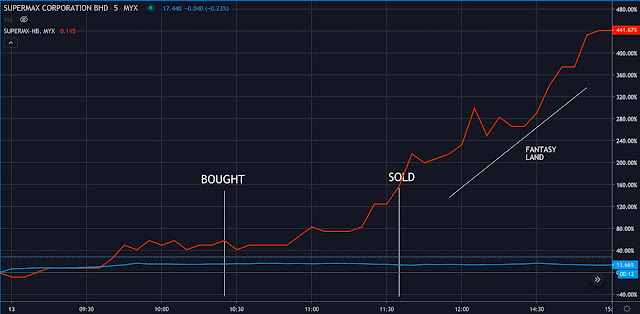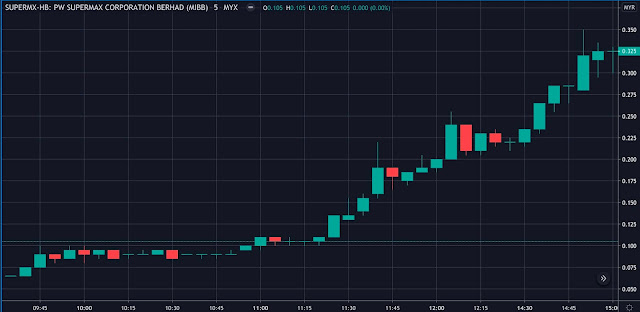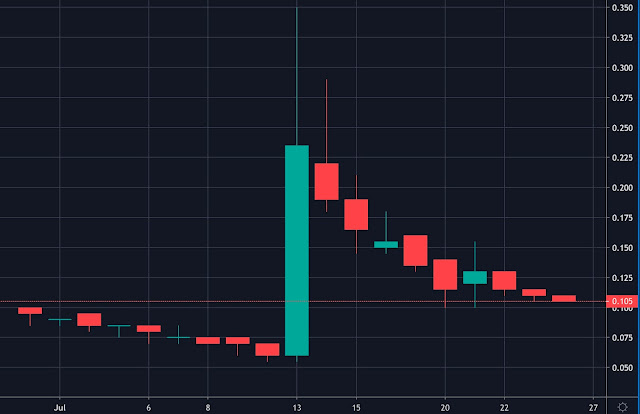This post first appeared at The Pelham Blue Fund, the premier investment and trading blog for Malaysia stocks and warrants.
Join our Telegram Channel for real time trade alerts and ideas. Join our community for daily updates and the best market insights on Bursa Malaysia stocks. 
From the Editor-In-Chief of the Pelham Blue Fund
The short version of the story : we made about RM48,000 in gross
profits before lunchtime by buying impossibly priced put warrants with
zero intrinsic value.
Was it gutsy? Reckless? Plain stupid? All this and more?
Now for the long version...
Outcome
Gross Profits : RM47,750
Return on Investment : 66%
Return on Investment : 66%
Duration : 1.5 hours
STOP MAKING SENSE
SUPERMX-HB was a recently issued put warrant. In the simplest terms, it
was meant to move in the opposite direction of the mother share. Stock
goes down, put warrant goes up, vice versa.
But not many are aware as to how this warrant works. With more than
50,000 new trading accounts opened in the past four months, to a newbie,
a warrant is just a warrant. A cheaper version of the real thing, and
it goes where the mother share goes.
In a market saturated with excessive speculation, especially in
skyrocketing gloves shares, it's not hard to make an honest mistake and
chase a put warrant. It's just one in a long list of available call
warrants, isn't it?
The 'H' in SUPERMX-HB is supposed to denote that it's a put warrant,
but who the hell would know that if they were not familiar with the
stock market?
BLACKPINK is the solution
An overheating market. An exotic trading instrument. A pool of new
investors/traders that are keen to push up anything glove-related under
the sun. All the ingredients were there for an explosive brew.
In this era of crazy, you'd get a put warrant that jumps a few hundred
percent in half a day. By luck or blissful stupidity, we made profits.
Others lost their shirts. It could easily have been the reverse.
So, to try and make sense of something like this, the question we should be asking is not "what the fuck?"
But first, a short diversion into some maths, because I know that's what you're really reading this blog post for.
CALCULATOR BREAKS DOWN
Only 243% moneyness?? Data as of 24 July 2020. Source: Malaysia Warrants
The put warrant's actual 'fair value' is easily quantifiable. But
there's a problem : when you actually do this, there's no way in hell
that the price makes sense.
Due to a multitude of factors which we will go into shortly, the put warrant fetched prices based on fantasy-land assumptions.
Source : The Edge
In terms of premiums, the put warrant was trading at between 100-300%
at their peaks. Peter Pan himself couldn't have explained it.
In terms of actual fair value, it gets even sketchier. Assuming a 15
sen price for SUPERMX-HB, SUPERMX shares would actually have an implied
value of RM2. The mother share would have to completely collapse for the
warrant to even be worth that much.
Price movement comparison in % terms between SUPERMX (blue) and
SUPERMX-HB (red). Notice that once the inverse correlation was broken,
the put warrant shot up a few hundred percent. The explanation I can
offer you is one word : Uncles.
To start with, I'll just include a list of questions that will elicit some digital grunts and puzzled emojis.
Why were people buying put warrants when their underlyings were rallying
to ALL TIME HIGHS?
Don't people know that put warrants are supposed to go down
when their underlyings are up?
Why did these put warrants skyrocket, even though their prices
make absolutely no sense on infinite Earths?
Where on earth were the market makers? Where were the price control mechanisms,
if any?
But the point of this is not to assign blame. I'm not here to find fault.
In fact, as an opportunistic trader, I might be the one at fault. Or
you can blame crazy uncles punting like crazy. On some days, I am that uncle.
Or you can blame an investing public that's largely unaware on how a
put warrant is supposed to work. Or you can ask the market maker where
they have been in all this.
Instead, it's far more useful to consider the factors and catalysts that made this absurd situation possible.
THE TRADE
Below is a percentage gains comparison between SUPERMX and SUPERMX-HB on 13 July 2020, from 9:00AM to 3:00PM.
The discrepancy was so huge that even though SUPERMX gained 14% in
half a day, its price chart looks totally flat in comparison to the put
warrant.
You read that right - SUPERMX-HB gained 441% by 3:00PM on this day.
I definitely started that day knowing that none of these things made
sense. The put warrant had already jumped 38% before we had even put on a
position.
But as a trader, I didn't let that stop me.
Some may find it grotesque, or offensive on an intellectual level, that
I can trade things that don't make sense. And I know exactly how put
warrants are supposed to work, and I was aware of the totally insane
pricing.
But I don't care what people think - I trade things that don't make sense all the time.
And because I count on these types of quirky market phenomena to make a
living, I can trade them well and survive to tell this tale.
When SUPERMX-HB suddenly gained in both price and volume, we deduced
that what was happening was an inexplicable breakout. And because our
specialty is in price-volume analysis, I can trade with zero context and
simply focus on the price and volume activity.
The first position was initiated after SUPERMX-HB had already gained
38%. We built up a not-so-minor position at 9 and 9.5 sen. Initially, we
figured that if we get this right, we stood to gain between 11% (at 10
sen) and 17% (at 10.5) in intraday gains. Really solid returns if that
happens.
It didn't take long for prices to break 10 sen. We noticed the steady
volumes buildup and just held on. During this time, the mother share was
still going up.
Within an hour and a half, it got to 15 sen. So we did the responsible
(??) thing by selling off this speculative position at around the
15-15.5 sen levels. 66% profits before lunchtime? Crazy.
But right after that... all hell broke loose. The put warrant did not
stop going up. By 11:40AM it hit 20 sen. And by 2:50PM, it would break
the 30 sen mark.
It was just full-on market mania. The market for this thing was
completely unhinged, and I can't say that I've seen anything quite like
it over nearly a decade of observing the stock market.
As it turned out, this period of insanity didn't last long. This
ridiculous rally sputtered over the next few days as some people came to
their senses, and a few more realised the absurdity of the whole thing
and had to dump their positions at massive losses.
In the tradition of history's greatest manias, the price movement
becomes parabolic. The daily chart here for SUPERMX-HB pretty much sums
it up.
So there you have it. Put warrant goes up. Logic goes out of the
window. Some uncles go bust. Others hit the jackpot. And soon after
this, people went on to speculate in other things.
Did anyone learn any valuable lesson from this? I doubt it. The lure of
a booming market is like a siren song : you can fall off a cliff, and
still keep walking. To most punters out there, old or new, this was just
another 'hot' move.
But that shouldn't be the whole story. This put warrant's boom and bust
encapsulates exactly the kind of mania that is going on in the stock
market right now, for better or worse, and it should never be forgotten.
WHAT WE LEARNED
I'm not saying that I can offer a satisfactory explanation to all this,
but we can try and analyse the situation a bit, to explore why and how
the put warrant can conceivably rise when the underlying was also
rising.
First, consider the market backdrop. We are in the midst of a short selling ban until the end of the year.
The mere existence of the put warrant - a unique instrument, especially
those of the single-stock variety - ironically makes it an appealing
instrument for investors who have a negative view on glove stocks. It's a
version of the scarcity premium - buying the put warrant is the only way to express this view.
The fact that glove stocks were breaching all-time highs did create a perverse incentive : the higher the stock goes, the more trading interest the put warrant will attract. Remember that this is currently the only way for people to express a bearish view on the stock.
It was plausible that a large swath of the market kept buying into the
put warrant because people were simply expecting a massive, precipitous
collapse in the glove stocks. Imagine expressing a sensible view by
buying into an insensibly priced warrant : did I mention that we are
living in crazy times?
But then again, to be conservative was the sensible view at the time.
Just three days before this momentous rally in SUPERMX-HB, the stock
exchange and regulator signaled their cautiousness about how loopy this
market was becoming. They introduced lower daily limits for KLCI
component stocks, which would directly affect the likes of TOPGLOV and
HARTA, the two major sector superstars in the year's hottest rally.
Full article here.
Remember that bearish view people had on glove stocks? SUPERMX-HB
rallied like stupid on 13 July, and the mother share kept going up.
Guess what happened on the 14th?
Big 4 Gloves Stocks, 5 minute chart on 14 July 2020. That valley was a flash crash.
What happened was... you know, just bubble market-type things.
SUPERMX itself had quite the dive. Its one-day range on 14 July looked like this:
So can we conclude that the put warrant did exactly as it was intended?
That it was pricing this huge collapse the day before, thus explaining
the entire crazy move?
The answer is : we don't know.
It didn't change the fact that the put warrant price made no sense at any price.
It didn't change the fact that the put warrant did not move inversely to the mother share as it ought to have done. But then again, it couldn't have: it was trading at levels where this could not logically happen.
What actually occurred was far messier: on 13 July, the put warrant
moved up while the mother share moved up. And when the mother moved down
on the 14th, the put warrant spiked upwards briefly and then went down
when the mother share recovered.
This sounds confusing simply because the price distortion was absolute,
and the put warrant simply lost all meaning as a hedging tool. As a
speculative tool, it worked out fine for some people, less so for those
caught at the top.
It was a new put warrant issuance, so shouldn't the market maker have
made some sort of price control or intervention to ensure orderly
trading, keep prices from getting out of whack, things like that? We
don't have an answer to that either.
If I was to sum up this whole weird episode, it's simply this : this
put warrant went wild in a wild market. No one exercised restraint, and
no one took control. And when a warrant doesn't do what it's supposed to
do, or priced where it's supposed to be priced, what you get is a
speculative frenzy gone bonkers.
No blame game here. If there's a shitshow in the markets, we are all responsible.
https://klse.i3investor.com/blogs/pelhambluefund/2020-07-26-story-h1510750302-We_Traded_SUPERMX_HB_and_Made_Big_Profits_But_Why_Did_It_Really_Gain_40.jsp














